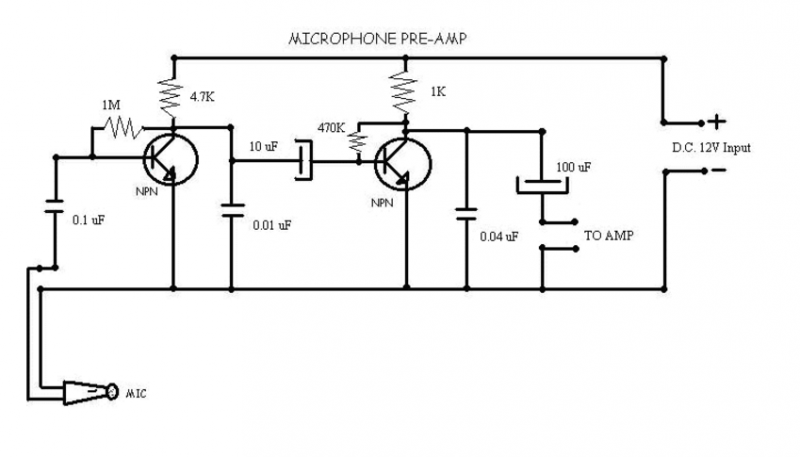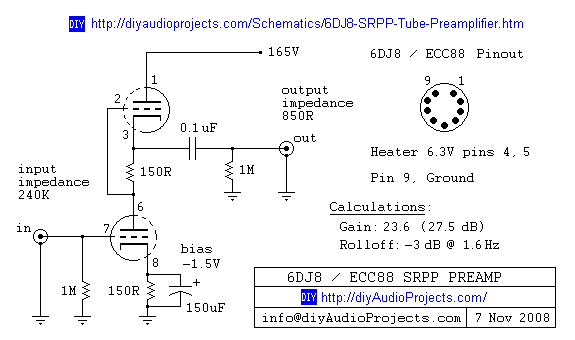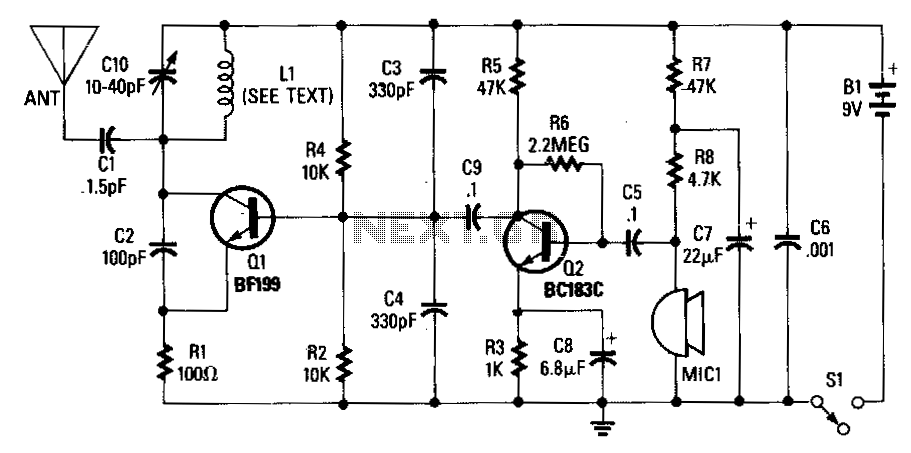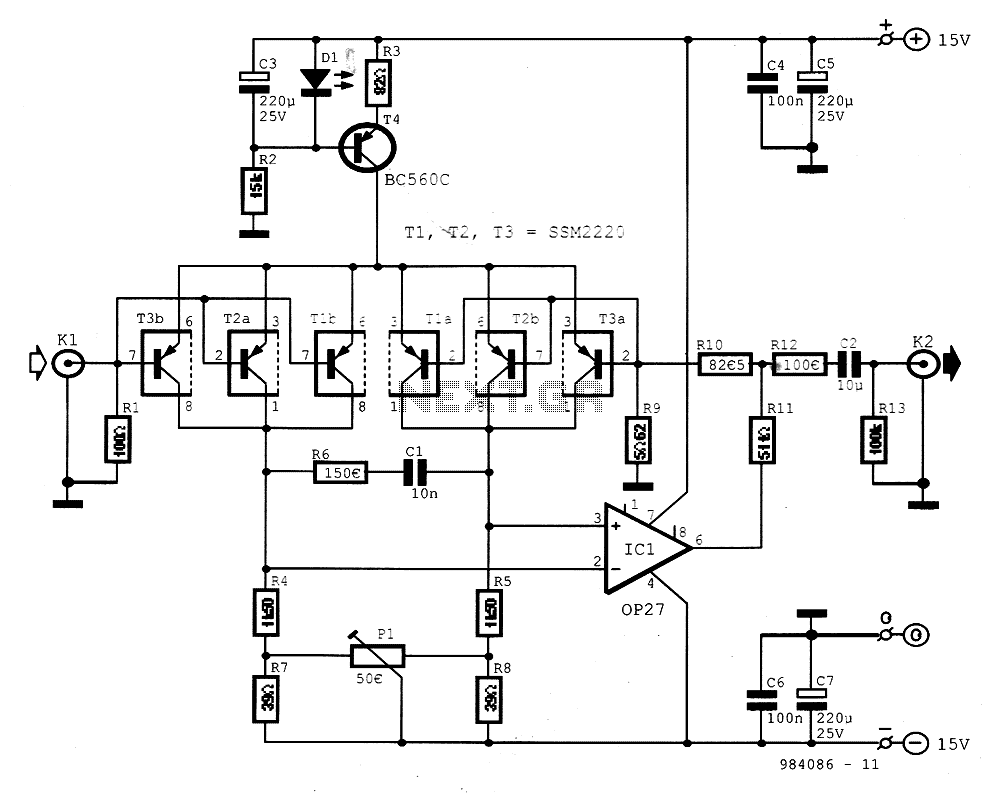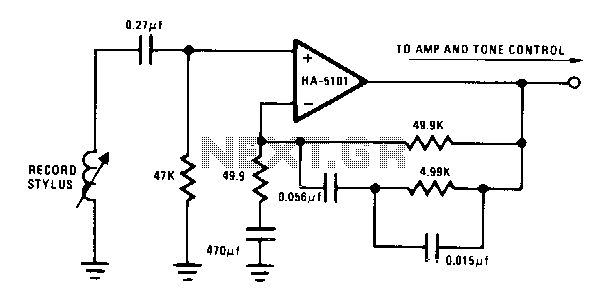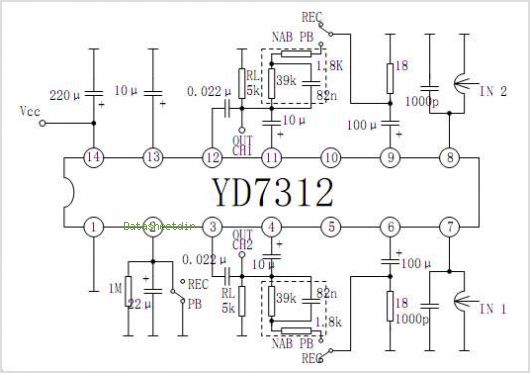
preamplifier for ecm microphone
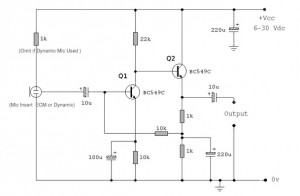
Both transistors should be low-noise types. The original circuit uses the BC650C, which is an ultra-low noise device. These transistors are now hard to find, but the BC549C or BC109C are good replacements. The circuit is self-stabilizing and will set its quiescent point at roughly half the supply voltage at the emitter of Q2. This allows maximum output voltage swing and the highest dynamic range. The electret condenser microphone (ECM) contains a very sensitive microphone element and an internal FET preamp, so a power supply in the range of 2 to 10 volts DC is necessary. Suitable ECMs may be obtained from Maplin Electronics. Although the schematic is drawn showing a three-terminal ECM, two-terminal ECMs may be used, with changes detailed in the practical section. The 1k resistor limits the current to the microphone. This resistor should be increased to 2.2k if a supply voltage above 12 volts DC is used, and it is not needed if the microphone insert is dynamic. The first stage amplifier, built around Q1, operates at a very low collector current. This factor contributes to a very high overall signal-to-noise ratio and low overall noise output. The emitter resistor of Q1 is decoupled by the 100µF capacitor, realizing maximum gain for this stage. The noise response of the amplifier, measured across the 10k load, is noted. The second stage, built around Q2, is direct-coupled, minimizing phase shift effects introduced with capacitive and inductive coupling methods, achieving a flat output response from 20Hz to over 100kHz. The frequency response measured across a 10k load resistor is plotted, simulated using a 12V power source. The emitter voltage of Q2 is also fed back to the base of Q1 via resistive coupling, ensuring bias stabilization against temperature effects. Q2 operates in emitter follower mode, with a voltage gain of less than unity; however, the overall voltage gain of the preamplifier is about 100x or 20dB. The output impedance is very low and well-suited to driving cables over distances of up to 50 meters, making screened cable unnecessary. This preamplifier has excellent dynamic range and can cope with anything from a whisper to a loud shout; however, care should be taken to ensure that the auxiliary equipment, i.e., amplifier or tape deck, does not overload.
The described circuit is a low-noise microphone preamplifier designed to amplify signals from an electret condenser microphone (ECM). The use of low-noise transistors, such as the BC549C or BC109C, enhances the overall performance by minimizing unwanted noise in the signal path. The circuit's self-stabilizing nature allows it to maintain a consistent quiescent point, which is crucial for optimal signal amplification and dynamic range.
The electret condenser microphone is a key component, featuring a highly sensitive microphone element and an internal FET preamplifier. The power supply requirements for the circuit range between 2 to 10 volts DC, ensuring compatibility with various ECMs available in the market. The inclusion of a 1k resistor limits the current flowing to the microphone, and adjustments to this resistor are necessary when operating at higher supply voltages to prevent damage to the microphone.
The first stage of amplification, centered around transistor Q1, operates at a low collector current, which is advantageous for achieving a high signal-to-noise ratio. The decoupling of the emitter resistor with a 100µF capacitor maximizes the gain for this stage, allowing for effective noise reduction. The design is optimized to ensure that the noise response remains low, as evidenced by measurements taken across a 10k load.
The second stage, utilizing transistor Q2, is direct-coupled to minimize phase shifts and achieve a flat frequency response across a wide range of audio frequencies, from 20Hz to over 100kHz. Feedback from the emitter of Q2 to the base of Q1 ensures that the biasing of the transistors remains stable under varying temperature conditions, further enhancing the reliability of the circuit.
In emitter follower mode, Q2 provides an output that is suitable for driving long cables without significant signal loss, making the use of screened cables unnecessary. The overall voltage gain of approximately 100x or 20dB indicates a robust amplification capability, allowing the preamplifier to handle a wide range of sound levels, from soft whispers to loud shouts, while ensuring that downstream audio equipment is not overloaded. This circuit exemplifies a well-designed low-noise preamplifier suitable for various audio applications.Both transistors should be low noise types. In the original circuit, is used BC650C which is an ultra low noise device. These transistors are now hard to find but BC549C or BC109C are a good replacement. The circuit is self stabilizing and will set its quiescent point at roughly half the supply voltage at the emitter of Q2. This allows maximum out put voltage swing and also the highest dynamic range. The electret condenser microphone (ECM) contains a very sensitive microphone element and an internal FET preamp, a power supply in the range 2 to 10 volts DC is therefore necessary. Suitable ECM`s may be obtained from Maplin Electronics. Although the schematic is drawn showing a three terminal ECM, two terminal ECM`s may be used, the following page in the practical section shows the changes.
The 1k resistor limits the current to the mic. This resistor should be increased to 2k2 if a supply voltage above 12 Volts DC is used and is not needed if the Mic insert is dynamic. The first stage amplifier built around Q1 is run at a very low collector current. This factor contributes to a very high overall signal to noise ratio and low overall noise output. The emitter resistor of Q1 is decoupled by the 100u realizing a maximum gain for this stage. The noise response of the amplifier measured across the 10k load is shown below. Please note that this plot was made with the mic insert replaced by a signal generator. The second stage, built around Q2 is direct coupled, this minimizes phase shift effects (introduced with capacitive and inductive coupling methods) and acheives a flat output response from 20Hz to over 100kHz.
The frequency response measured across a 10k load resistor is plotted below simulated using a 12V power source: The emitter voltage of Q2 is also fed back to the base of Q1 via resistive coupling. This also ensures bias stabilization againt temperature effects. Q2 operates in emitter follower mode, the voltage gain of this stage is less than unity, however, the overall voltage gain of the preamplifier is about 100x or 20dB as shown in the bode plot above.
The output impedance is very low and well suited to driving cables over distances up to 50 meters. Screened cable therefore is not necessary. This preamplifier has excellent dynamic range and can cope with anything from a whisper to a loud shout, however care should be taken to make sure that the auxiliary equipment i. e. amplifier or tape deck does not overload. 🔗 External reference
The described circuit is a low-noise microphone preamplifier designed to amplify signals from an electret condenser microphone (ECM). The use of low-noise transistors, such as the BC549C or BC109C, enhances the overall performance by minimizing unwanted noise in the signal path. The circuit's self-stabilizing nature allows it to maintain a consistent quiescent point, which is crucial for optimal signal amplification and dynamic range.
The electret condenser microphone is a key component, featuring a highly sensitive microphone element and an internal FET preamplifier. The power supply requirements for the circuit range between 2 to 10 volts DC, ensuring compatibility with various ECMs available in the market. The inclusion of a 1k resistor limits the current flowing to the microphone, and adjustments to this resistor are necessary when operating at higher supply voltages to prevent damage to the microphone.
The first stage of amplification, centered around transistor Q1, operates at a low collector current, which is advantageous for achieving a high signal-to-noise ratio. The decoupling of the emitter resistor with a 100µF capacitor maximizes the gain for this stage, allowing for effective noise reduction. The design is optimized to ensure that the noise response remains low, as evidenced by measurements taken across a 10k load.
The second stage, utilizing transistor Q2, is direct-coupled to minimize phase shifts and achieve a flat frequency response across a wide range of audio frequencies, from 20Hz to over 100kHz. Feedback from the emitter of Q2 to the base of Q1 ensures that the biasing of the transistors remains stable under varying temperature conditions, further enhancing the reliability of the circuit.
In emitter follower mode, Q2 provides an output that is suitable for driving long cables without significant signal loss, making the use of screened cables unnecessary. The overall voltage gain of approximately 100x or 20dB indicates a robust amplification capability, allowing the preamplifier to handle a wide range of sound levels, from soft whispers to loud shouts, while ensuring that downstream audio equipment is not overloaded. This circuit exemplifies a well-designed low-noise preamplifier suitable for various audio applications.Both transistors should be low noise types. In the original circuit, is used BC650C which is an ultra low noise device. These transistors are now hard to find but BC549C or BC109C are a good replacement. The circuit is self stabilizing and will set its quiescent point at roughly half the supply voltage at the emitter of Q2. This allows maximum out put voltage swing and also the highest dynamic range. The electret condenser microphone (ECM) contains a very sensitive microphone element and an internal FET preamp, a power supply in the range 2 to 10 volts DC is therefore necessary. Suitable ECM`s may be obtained from Maplin Electronics. Although the schematic is drawn showing a three terminal ECM, two terminal ECM`s may be used, the following page in the practical section shows the changes.
The 1k resistor limits the current to the mic. This resistor should be increased to 2k2 if a supply voltage above 12 Volts DC is used and is not needed if the Mic insert is dynamic. The first stage amplifier built around Q1 is run at a very low collector current. This factor contributes to a very high overall signal to noise ratio and low overall noise output. The emitter resistor of Q1 is decoupled by the 100u realizing a maximum gain for this stage. The noise response of the amplifier measured across the 10k load is shown below. Please note that this plot was made with the mic insert replaced by a signal generator. The second stage, built around Q2 is direct coupled, this minimizes phase shift effects (introduced with capacitive and inductive coupling methods) and acheives a flat output response from 20Hz to over 100kHz.
The frequency response measured across a 10k load resistor is plotted below simulated using a 12V power source: The emitter voltage of Q2 is also fed back to the base of Q1 via resistive coupling. This also ensures bias stabilization againt temperature effects. Q2 operates in emitter follower mode, the voltage gain of this stage is less than unity, however, the overall voltage gain of the preamplifier is about 100x or 20dB as shown in the bode plot above.
The output impedance is very low and well suited to driving cables over distances up to 50 meters. Screened cable therefore is not necessary. This preamplifier has excellent dynamic range and can cope with anything from a whisper to a loud shout, however care should be taken to make sure that the auxiliary equipment i. e. amplifier or tape deck does not overload. 🔗 External reference
Warning: include(partials/cookie-banner.php): Failed to open stream: Permission denied in /var/www/html/nextgr/view-circuit.php on line 713
Warning: include(): Failed opening 'partials/cookie-banner.php' for inclusion (include_path='.:/usr/share/php') in /var/www/html/nextgr/view-circuit.php on line 713
